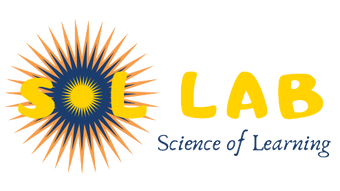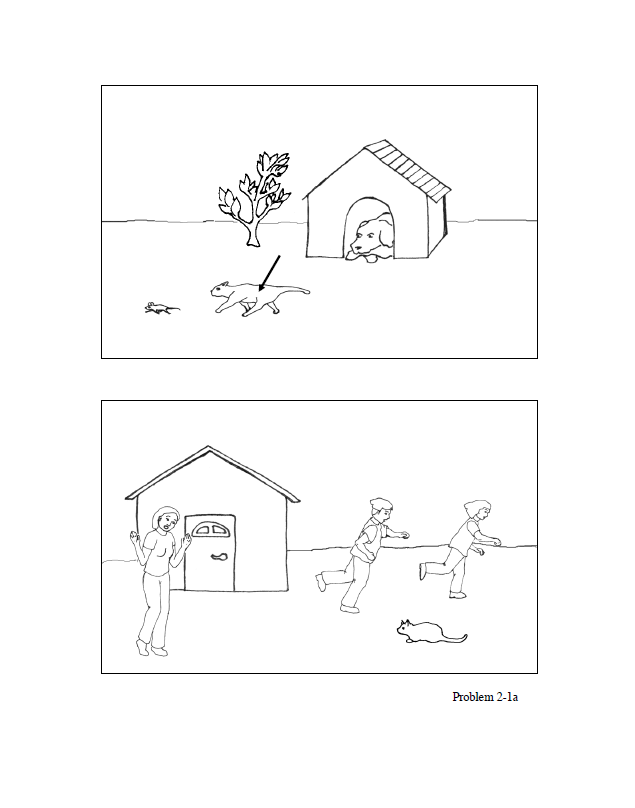Development of Higher-Order Thinking
This project traces the emergence and development of higher-order thinking in young children. Higher-order thinking is a type of relational reasoning where two representations are linked together, through the use of inferences, comparisons, abstractions, and hierarchies. By linking together representations, children become able to represent complex concepts, organize information into knowledge structures, and make inferences based on their knowledge. As such, developing HOT skills is a long-standing educational goal, as these skills can be used to develop knowledge that crosses domains.
Using a longitudinal database of a diverse sample of children and parents recruited from the Chicago area, we examine the frequency of HOT use in spontaneous parent-child interactions, and link these language practices to children's later cognitive and linguistic outcomes in grade school and beyond. An additional line of work examines the contexts under which parents and children invoke higher-order thinking, including personal narrative talk and pretend play.
Far Scene Analogy Studies
When you ask a child, "How is a plant stem like a drinking straw?", they could respond in a variety of different ways. Some children, especially younger children, might focus on the appearance of the objects, and will say that both plant stems and drinking straws are long and skinny. Other children might focus on relational similarities: both are used to deliver liquids, and both use pressure to move liquid up the shaft. The latter is known as an analogy, which is a kind of similarity in which the same system of relations holds across different objects.
|
This project seeks to explore different possible mechanisms underlying the relational shift, including: 1) children's executive functions (i.e. the ability to regulate their own thinking, including inhibitory control, working memory, and task-switching) 2) parent socialization of attention to perceptual versus relational similarities We conduct experimental work to examine the contributions of these skills, as well as studies to test whether priming for analogical thinking and attention - a relational mindset - is possible. |
Many of our studies use The Scene Analogy Task. This task asks children to identify relational patterns between dissimilar subjects while ignoring irrelevant distracting information. We find that children's ability to attend to relevant relational structures decreases with the complexity of the relationship and with the presence of distracting irrelevant information.
Dr. Richland's Scene Analogy Task and instructions are available. Please find the different files below:
Scene Analogy Stimuli
Scene Analogy Answer Key
Scene Analogy Instructions
Scene Analogy Counterbalance Key
Scene Analogy Stimuli
Scene Analogy Answer Key
Scene Analogy Instructions
Scene Analogy Counterbalance Key
For a brief summary of our recent findings, please view the following video produced by the National Science Foundation.
Computational Models
To understand the interaction of processing capacities and relational knowledge in the scene analogy task, we modeled results from Richland, Chan, Morrison, and Au (2010) in two computational simulations: LISA (Learning and Interference with Schema and Analogies; Hummel & Holyoak, 1997, 2003) and DORA (Discovery of Relations by Analogy; Doumas & HUmmel, 2005 a; Doumas et al., 2008).
These simulations led us to propose a model for how inhibitory control and relational knowledge acquisition interact within children's relational reasoning. Specifically, we model U.S and cross-cultural data to suggest that increasing relational knowledge allows children to re-represent structured systems into more manageable relational groupings, thus reducing processing demands on working memory and leading children to successfully solve more complex analogies. In contrast, our models and data suggest that individual differences in inhibitory control are based on maturation and unrelated to relational knowledge acquisition.
For more on our cross-cultural analogy work please see our International Use of Analogies page.
These simulations led us to propose a model for how inhibitory control and relational knowledge acquisition interact within children's relational reasoning. Specifically, we model U.S and cross-cultural data to suggest that increasing relational knowledge allows children to re-represent structured systems into more manageable relational groupings, thus reducing processing demands on working memory and leading children to successfully solve more complex analogies. In contrast, our models and data suggest that individual differences in inhibitory control are based on maturation and unrelated to relational knowledge acquisition.
For more on our cross-cultural analogy work please see our International Use of Analogies page.
Publications
Richland, L.E., Burchinal, M. (2013). Early executive function predicts reasoning development,
Psychological Science. vol. 24 no. 1 87-92.
Morrison, R.G., Leonidas Doumas, A.A., & Richland, L.E. (2010). A computational account of
children’s analogical reasoning: Balancing inhibitory control in working memory and relational
representation. Developmental Science. 14 (3), 516-529.
Richland, L.E., Chan, T-K., Morrison, R.G., & Au, T. K-F (2010), Young children’s analogical reasoning
across cultures: similarities and differences. Journal of Experimental Child Psychology. 105,
146-15.
Richland, L.E., Morrison, R.G., & Holyoak, K.J. (2006). Children’s development of analogical reasoning:
Insights from scene analogy problems. Journal of Experimental Child Psychology, 94, 249–273.
Morrison, R.G., Doumas, L.A.A., & Richland, L.E. (2006). The development of analogical reasoning in
children: A computational account. In Proceedings of the Twenty-Eighth Annual Conference of the
Cognitive Science Society. Mahwah, NJ: Lawrence Erlbaum.
Psychological Science. vol. 24 no. 1 87-92.
Morrison, R.G., Leonidas Doumas, A.A., & Richland, L.E. (2010). A computational account of
children’s analogical reasoning: Balancing inhibitory control in working memory and relational
representation. Developmental Science. 14 (3), 516-529.
Richland, L.E., Chan, T-K., Morrison, R.G., & Au, T. K-F (2010), Young children’s analogical reasoning
across cultures: similarities and differences. Journal of Experimental Child Psychology. 105,
146-15.
Richland, L.E., Morrison, R.G., & Holyoak, K.J. (2006). Children’s development of analogical reasoning:
Insights from scene analogy problems. Journal of Experimental Child Psychology, 94, 249–273.
Morrison, R.G., Doumas, L.A.A., & Richland, L.E. (2006). The development of analogical reasoning in
children: A computational account. In Proceedings of the Twenty-Eighth Annual Conference of the
Cognitive Science Society. Mahwah, NJ: Lawrence Erlbaum.



